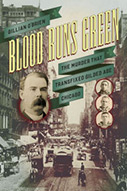Blood Runs Green: The Murder That Transfixed Gilded Age Chicago

Author: Gillian O’Brien
Publisher: Chicago, IL: The University of Chicago Press, 2015. 320p.
Reviewer: David J. Bodenhamer | July 2015
In 1889 over 12,000 Chicagoans filed past the coffin of Dr. Patrick Henry Cronin in the city’s largest funeral since Abraham Lincoln’s body had lain in state in 1865. By the time his assailants were tried and convicted in a trial that lasted weeks, the story of Cronin’s murder had become known to newspaper readers around the world. It was a sensational tale that exposed corruption in the Chicago police force and, more important, weakened support for Irish republicanism in the United States. Gillian O’Brien has rescued this story from obscurity in this carefully researched and clearly written book. In doing so, she gives the complex international politics a human face and helps readers understand how a thuggish act of brutality could roil trans-Atlantic diplomacy for decades.
More well-known in death than in life, Cronin was an Irish nationalist who was murdered by rivals in the secret Clan na Gael, a society dedicated to the end of British rule in Ireland by violence if necessary. The Clan, one of a number of Irish national groups operating in the United States, was among the most radical — sending arms, munitions, and men to Belfast, Dublin, and elsewhere, and orchestrating a bombing campaign in British and Scottish cities to force independence. Cronin’s exposure of the Clan’s methods, especially the so-called dynamite war, led to a confrontation with Andrew Sullivan, a political operative and the elected leader of the Clan executive committee and president of the Irish National League of America. The clash between Cronin and Sullivan was a symptom of a larger splintering among Irish nationalists in the United States, which threatened Sullivan’s ambitions. His allies engineered Cronin’s dismissal from the Clan, and Cronin’s allies in turn levied charges of corruption against Sullivan and the Clan leadership. The internal trial attracted significant press coverage, with a key witness linking the dynamite campaign to Charles Stewart Parnell, the founder and leader of the Irish Parliamentary Party, who at that moment was the subject of a judicial inquiry in Great Britain. The result was great damage to the Irish national cause. In Chicago, Sullivan’s forces identified Cronin as the culprit and beat him to death in retribution.
Newspapers made the Cronin murder front page news for months while the investigation continued. Competition among papers also led to serious reporting into the incompetence, corruption, and partisanship of Chicago police, a third of whom were Irish. Public opinion turned against the Clan, in part because of its association with violence. (The Haymarket Affair, an alleged anarchist-led bombing of a Chicago labor rally, had occurred only three years earlier.) Dime museums featured the crime, and numerous fictional accounts of the murder appeared. It was grand public entertainment.
Readers interested in contemporary police methods and in the details of the trial will not be disappointed. Although O’Brien adds nothing new to our knowledge of late nineteenth century criminal justice, she provides details that often escape the notice of scholars. For instance, she recounts the voir dire in some detail, outlines the state’s case and the strategy of the defense, identifies and explains the reasons why a lone juror refused to vote for the death penalty, and even lists the items that comprised the gargantuan breakfasts fed to the jury each day. Significantly, she never views the trial in isolation from the public response to it or to its importance for the larger Irish question.
Gillian O’Brien deserves praise for an engaging and well-written account of a key event that should not have been so easily lost to history. Blood Runs Green is a worthy addition to any bookshelf on Irish nationalism, late nineteenth-century Chicago, and urban policing.
David J. Bodenhamer is Executive Director of The Polis Center and Professor of History at Indiana University Purdue University, Indianapolis


